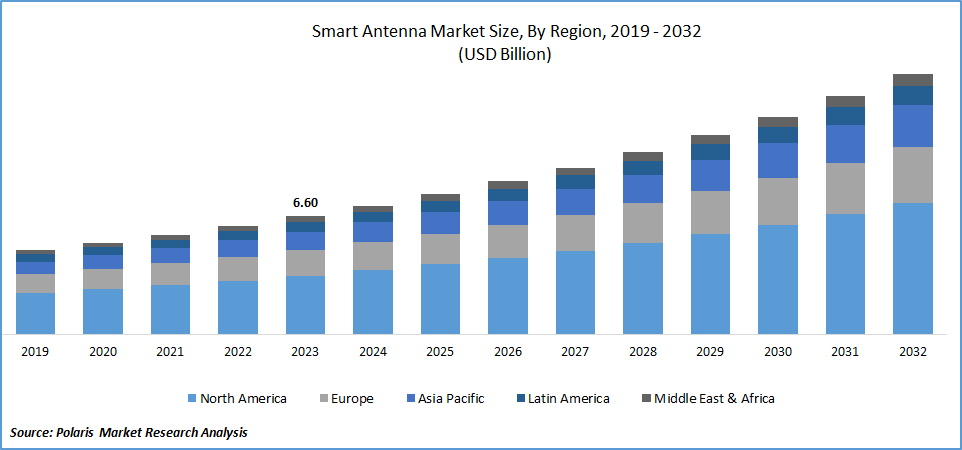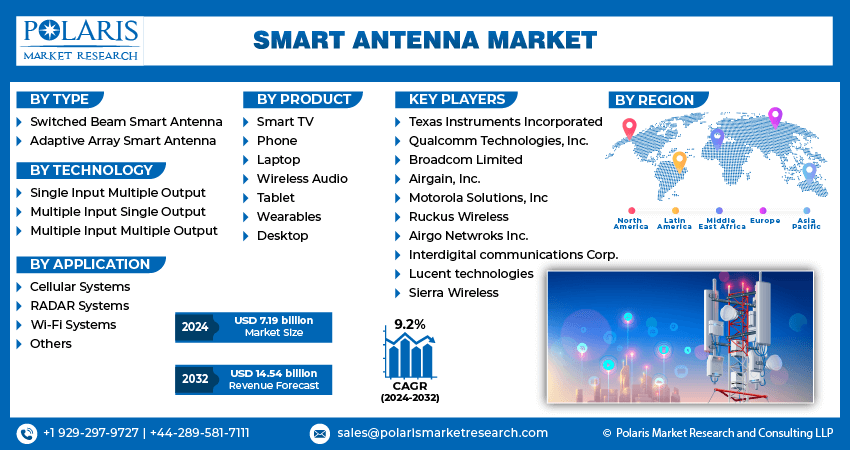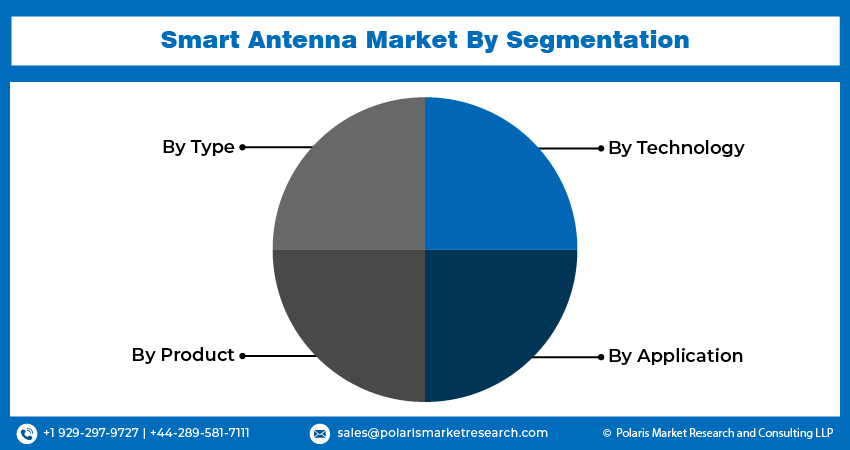
Smart Antenna Market Size, Share, Trends, Industry Analysis Report
: By Type, By Technology (SIMO, MIMO, MISO), By Product, By Application, and By Region – Market Forecast, 2025 - 2034
- Published Date:May-2025
- Pages: 147
- Format: PDF
- Report ID: PM1454
- Base Year: 2024
- Historical Data: 2020-2023
The global smart antenna market was valued at USD 12.8 billion in 2024 and is anticipated to grow at a CAGR of 16.90% from 2025 to 2034. The market is growing due to rising mobile data traffic and demand for better wireless communication quality.
The smart antenna is a technology that enhances wireless communication by improving signal quality, increasing data rates, and reducing interference in applications like mobile phones, Wi-Fi networks, and satellite communications. The smart antenna market is experiencing robust growth driven by advancements in technology that enable secure and high-speed two-way communication. Moreover, the reliance of industries on rapid two-way communication due to modern technological advancements also boosts the overall growth.

To Understand More About this Research:Request a Free Sample Report
The growing demand for secure long-distance data transmission is another major contributor to the expansion of the industry size. The market is expanding with the increased digital connectivity and the rising implementation of 5G millimeter-wave radio frequencies in devices such as mobiles, 5G smartphones, and others.
Smart Antenna Market Trends
Rising Internet of Things (IoT) Applications
The smart antenna is being driven by the growing proliferation of the IoT devices as they require reliable and efficient connectivity to transmit data over networks. It provide connectivity by improving signal strength, enhancing coverage, and minimizing interference.
These antennas also enable IoT devices to maintain stable connections in challenging environments, ensuring seamless data transmission critical for real-time monitoring, analytics, and automation.
For instance, in December 2023, Quectel launched six new antennas specifically to enhance connectivity performance for IoT devices. These antennas cater to a diverse array of applications, spanning from 5G to non-terrestrial networks (NTNs), thereby offering customers innovative capabilities.
IoT applications are also expanding across various industries, such as healthcare, manufacturing, transportation, and smart cities, propelling the demand for robust wireless communication solutions.
Rising Adoption of 5G Technologies in Smart Antenna
The market is experiencing significant growth, driven by the rising adoption of 5G technologies. 5G networks operate at higher frequencies and use new technologies, such as massive MIMO (Multiple Input Multiple Output), to achieve significantly faster data speeds and lower latency compared to previous generations.
For instance, in July 2022, according to the World Bank Asia Pacific Data, five out of the eight Asian countries’ 5G population coverage surpassed 50 percent as compared to 2020. The number of publicly announced 5G enterprise deployments has risen by 114 percent across the eight countries.
5G services support a massive increase in connected devices and applications, ranging from autonomous vehicles to smart cities and industrial automation. It enable 5G networks to deliver reliable connectivity, improved coverage, and enhanced spectral efficiency, driving the market revenue.

Segmental Analysis
Market Breakdown by Technology Insights
The segmentation, based on technology, includes SIMO (Single Input Multiple Output), MIMO (Multiple Input Single Output), and MISO (Multiple Input Multiple Output). The MIMO segment is expected to register the highest CAGR during the forecast period due to its ability to enhance wireless communication performance. MIMO increases data throughput, improves spectral efficiency, and enhances reliability by mitigating fading and interference.
The growing demand for high-speed data converters in wireless networks makes MIMO a preferred choice in sectors such as telecommunications, Wi-Fi networks, and 5G deployments.
For instance, in February 2024, Ericsson deployed Massive MIMO 5G radios for Airtel in 12 telecom circles as part of Airtel’s MINI-LINK (microwave) and 5G Radio Access Network for mobile transport portfolios.
Market Breakdown by Application Insights
The segmentation, based on application, includes Wi-Fi systems, cellular systems, WiMAX systems, RADAR sensor, and others. The cellular systems segment dominated the market in 2024 owing to its application in smart antennas. Cellular systems use a cluster of smart antennas to enhance signal strength and quality effectively. These systems, along with smart antenna, drive the implementation of 4G and 5G networks.
For instance, in November 2023, according to the Ministry of State for Communications, 5G networks were implemented in 738 districts across India, with a total of 3,94,298 base stations set up to serve up to 100 million subscribers utilizing 5G network, boosting the overall growth.

Source: Secondary Research, Primary Research, PMR Database, and Analyst Review
Smart Antenna Regional Insights
By region, the study provides insights into North America, Europe, Asia Pacific, Latin America, the Middle East & Africa. In 2024, the North America smart antenna market accounted for the largest share owing to the presence of significant technology firms specialized in telecommunications and wireless technologies. This fosters innovation and rapid development of systems.
For instance, in July 2024, Adant Technologies Inc. introduced the sMART-2E, an innovative, affordable smart antenna solution with a low-profile design, aimed at transforming connectivity for small and medium businesses (SMB), multi-dwelling units (MDU), and enterprise networks in the United States.
The key players are deploying antennas in industries such as agriculture, construction, and others to strengthen their presence and serve better offerings in North America, further driving the market during the forecast period.
For instance, in April 2022, Volvo Construction Equipment entered into a distribution agreement with Hemisphere GNSS to distribute their latest S631 GNSS smart antennas along with control and data transfer solutions to construction industries.
The Asia Pacific smart antenna market is expected to grow at the highest CAGR from 2025 to 2034 because the region are ensuring smooth wireless connectivity for high-speed communication systems. The rising adoption of 5G networks and the expansion of the IoT in this region is driving the market expansion.
For instance, according to the 2023 Mobile Economy report, 5G will make up 41% of mobile connections in the Asia Pacific region by 2030, marking a tenfold increase from the 4% recorded in 2022. This growth is expected to bring in over US$133 billion to the regional economy.

Source: Secondary Research, Primary Research, PMR Database, and Analyst Review
Telecommunications operators and network equipment manufacturers are rolling out 5G networks equipped with advanced MIMO capabilities, driving innovation and collaboration in the smart antenna market.
For instance, in June 2023, u-blox and Tallysman Wireless Inc. entered into an innovation agreement to collaborate on the development of advanced PointPerfect PPP-RTK smart antennas. The PointPerfect GNSS augmentation service will be accessible in Europe, North America, and specific areas of Asia Pacific.
Key Market Players & Competitive Insights
Leading players are investing heavily in research and development in order to expand their product lines, which will helps to grow even more. Participants are also undertaking a variety of strategic activities to expand their global footprint, with important developments including new product launches, contractual agreements, mergers and acquisitions, higher investments, and collaborations with other organizations. To expand and survive in a more competitive and rising climate, the smart antenna market must offer cost-effective items.
Manufacturing locally to minimize operational costs is one of the key business tactics used by manufacturers. In recent years, it has offered some technological advancements. Major players include Airgain Inc., Amphenol Corporation, Broadcom Limited, Galtronics USA Ltd., Intel Corporation, Linx Technologies, Molex LLC, Qualcomm Technologies, Inc., Sierra Wireless, and Sunway Communication.
Linx Technologies, headquartered in the United States, is a manufacturing company that specializes in wireless components, including RF connectors, antennas, modules, and remote controls. It makes wireless technology accessible for engineers through its products. In March 2023, Linx Technologies launched a line of cellular adhesive flexible printed circuit (FPC) antennas. These antennas are specifically crafted to cater to the needs of cellular IoT (LTE-M, NB-IoT), 5G New Radio, and LTE applications, providing an economical and adaptable antenna solution.
Qualcomm Technologies, Inc. is a company that develops and commercializes foundational technologies for the wireless industry. The company’s Snapdragon platforms are used to power the AR, VR, and MR devices. It has three reportable business segments: Qualcomm Technology Licensing, Qualcomm CDMA Technologies, and Qualcomm Strategic Initiatives. In February 2024, Qualcomm Technologies, Inc. introduced the Snapdragon X80 5G Modem-RF System, representing the seventh evolution of its 5G modem-to-antenna platform.
List of Key Companies
- Airgain Inc.
- Amphenol Corporation
- Broadcom Limited
- Galtronics USA Ltd.
- Intel Corporation
- Linx Technologies
- Molex LLC
- Qualcomm Technologies, Inc.
- Sierra Wireless
- Sunway Communication
Smart Antenna Market Developments
- December 2024: GeoMax launched the Zenith55 GNSS smart antenna and TRU35 high-power UHF radio. These advanced products, designed for construction and surveying, integrated seamlessly with GeoMax equipment, offering enhanced precision, productivity, and reliable performance.
- May 2024: Point One Navigation and Calian GNSS collaborated to offer seamless Smart GNSS Antenna support for Polaris RTK to provide innovative healthcare, learning, communications, and cybersecurity solutions.
- April 2024: Leica Geosystems introduced the Leica iCON gps 120, a smart antenna that offers adaptable and versatile machine control solutions, at the construction trade show Intermat in France.
- October 2023: Zyxel Networks launched its latest Wi-Fi 7 AP, showcasing unparalleled speed, adaptive antenna technology, anti-noise shielding, and other cutting-edge capabilities.
Smart Antenna Market Segmentation
By Type Outlook
- Switched Beam Smart Antenna
- Adaptive Array Smart Antenna
- FPC Smart Antenna
- LDS Smart Antenna
- MPI Smart Antenna
- LCP Smart Antenna
By Technology Outlook
- SIMO (Single Input Multiple Output)
- MIMO (Multiple Input Single Output)
- MISO (Multiple Input Multiple Output)
By Product Outlook
- Smart TV
- Phone
- Laptop
- Wireless Audio
- Tablet
- Wearables
- Desktop
By Application Outlook
- Wi-Fi Systems
- Cellular Systems
- WiMAX Systems
- RADAR Systems
- Others
By Regional Outlook
- North America
- US
- Canada
- Europe
- Germany
- France
- UK
- Italy
- Spain
- Netherlands
- Russia
- Rest of Europe
- Asia-Pacific
- China
- Japan
- India
- Malaysia
- South Korea
- Indonesia
- Australia
- Vietnam
- Rest of Asia-Pacific
- Middle East & Africa
- Saudi Arabia
- UAE
- Israel
- South Africa
- Rest of Middle East & Africa
- Latin America
- Mexico
- Brazil
- Argentina
- Rest of Latin America
Smart Antenna Report Scope
|
Report Attributes |
Details |
|
Market Size Value in 2024 |
USD 12.8 billion |
|
Market Size Value in 2025 |
USD 14.96 billion |
|
Revenue Forecast in 2034 |
USD 59.4 billion |
|
CAGR |
16.90% from 2024 – 2032 |
|
Base Year |
2024 |
|
Historical Data |
2020 – 2023 |
|
Forecast Period |
2025 – 2034 |
|
Quantitative Units |
Revenue in USD billion and CAGR from 2025 to 2034 |
|
Report Coverage |
Revenue Forecast, Competitive Landscape, Growth Factors, and Trends |
|
Segments Covered |
|
|
Regional Scope |
|
|
Competitive Landscape |
|
|
Report Format |
|
|
Customization |
Report customization as per your requirements with respect to countries, regions, and segmentation. |
FAQ's
The global smart antenna market size was valued at USD 12.8 billion in 2024 and is projected to be valued at USD 59.4 billion in 2034.
The global market is projected to register at a CAGR of 16.9% during the forecast period, 2024-2032
North America had the largest share of the global market
The key players in the market are Airgain Inc., Amphenol Corporation, Broadcom Limited, Galtronics USA Ltd., Intel Corporation, Linx Technologies, Molex LLC, Qualcomm Technologies, Inc., Sierra Wireless, and Sunway Communication.
The MIMO (Multiple Input Single Output) category is expected to grow at the highest CAGR in the market.
The cellular system held the largest share of the global market
